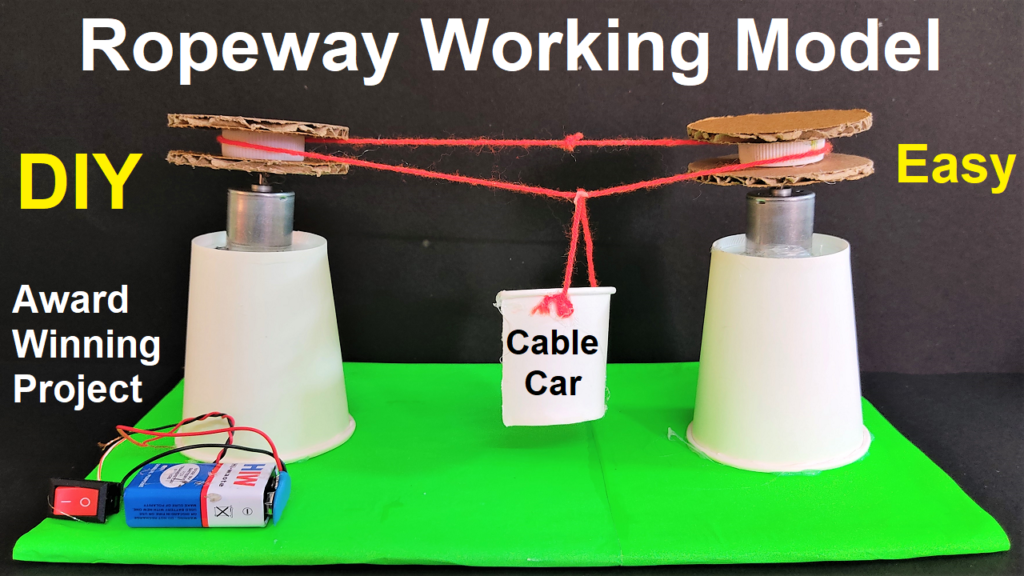A ropeway, also known as an aerial tramway or cable car, is a transportation system that uses a continuously moving cable to transport cabins or gondolas between two or more stations.
It’s commonly used to transport people or goods across challenging terrains, such as mountains or bodies of water.
Here’s how a ropeway working model typically operates:
Creating a ropeway working model using paper cups as pillars, circular cardboard, a DC motor, a 9V battery, and threads can be a fun and educational project. This model simulates a basic transportation system using a ropeway mechanism.

Here’s a step-by-step guide:
Materials Needed:
- Paper cups (for pillars)
- Circular cardboard (as the base)
- DC motor
- 9V battery with connector
- Threads or strings
- Small lightweight container or basket (for transportation)
- Glue, tape, or adhesive putty
- Hot glue gun (optional, for securing the motor)
video steps instructions :
- Prepare the Base:
- Place the circular cardboard on a flat surface. This will serve as the base of the ropeway.
- Assemble the Paper Cup Pillars:
- Turn the paper cups upside down.
- Attach the cups to the circular cardboard as pillars using glue, tape, or adhesive putty. Space them evenly around the edge of the cardboard.
- Attach the Motor:
- Attach the DC motor to the center of the circular cardboard using glue or adhesive putty.
- Make sure the motor’s shaft is aligned with the center of the cardboard.
- Create the Ropeway System:
- Attach one end of a thread to the motor’s shaft.
- Run the thread from the motor to one of the paper cup pillars, then back to the motor, forming a loop.
- Assemble the Transport Container:
- Attach the other end of the thread to a small, lightweight container or basket.
- This container will represent the “transportation” moving along the ropeway.
- Connect the Battery:
- Connect the 9V battery to the motor using the appropriate connectors.
- Depending on the motor’s specifications, you may need to use a switch or a transistor to control the motor’s operation.
- Testing the Model:
- Turn on the battery, and the motor will start rotating, pulling the thread and moving the container along the ropeway loop.
- The circular motion of the motor will create a continuous movement of the container between the pillars.
- Adjustments:
- Experiment with the speed of the motor to find the right balance between movement and stability.
- Adjust the tension of the thread to prevent it from getting tangled or snagged.
This ropeway working model provides a hands-on demonstration of a basic transportation system. It’s a creative way to learn about simple machines, motion, and energy conversion.
questions asked in science exhibition on ropeway working model with answers
Question 1: What is a ropeway?
Answer: A ropeway, also known as an aerial tramway or cable car, is a transportation system that uses a continuously moving cable to transport cabins or gondolas between two or more stations.
Question 2: How does a ropeway work?
Answer: A ropeway works by suspending cabins or gondolas from a continuously moving cable loop. The cable is driven by a motor at one station, which propels the cabins from one station to another.
Question 3: What are the main components of a ropeway working model?
Answer: The main components include the cable loop, cabins or gondolas, drive mechanism (motor and bullwheel), tensioning system, counterweight system, and support towers.
Question 4: How is the movement of the cabins controlled?
Answer: The movement of the cabins is controlled by the drive mechanism located at one station. The motor rotates the bullwheel, which in turn moves the cable loop and propels the cabins.
Question 5: What is the purpose of the counterweight system?
Answer: The counterweight system helps balance the weight of the cabins, ensuring smooth and efficient operation. It reduces strain on the drive mechanism and maintains proper tension in the cable.
Question 6: What types of areas or terrains are suitable for ropeways?
Answer: Ropeways are suitable for transporting people or goods across challenging terrains, such as mountains, rivers, valleys, and urban areas with difficult access.
Question 7: What are the advantages of using a ropeway for transportation?
Answer: Ropeways are environmentally friendly, offer scenic views, can overcome challenging terrains, reduce congestion in urban areas, and provide efficient transportation solutions.

